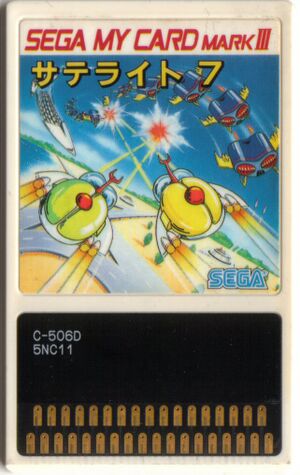Difference between revisions of "Sega MyCard"
From Sega Retro
m (section naming, formatting, order) |
(Removed sentence about MyCards being region free, as most have software region checks etc so this is not the case, todo: elaborate on that, but in the mean time important not to spread misinformation which could actually cost someone money) |
||
| Line 6: | Line 6: | ||
In Europe the majority of games distributed on card were re-released on cartridge (the exception being [[Great Soccer]], which had already been discontinued since being superseded by [[World Soccer]]). However, the US card games failed to see a cartridge re-release, whilst the Sega Master System had already been discontinued in Japan by this point. | In Europe the majority of games distributed on card were re-released on cartridge (the exception being [[Great Soccer]], which had already been discontinued since being superseded by [[World Soccer]]). However, the US card games failed to see a cartridge re-release, whilst the Sega Master System had already been discontinued in Japan by this point. | ||
| − | + | The [[Power Base Converter]] was the last piece of hardware to contain a card slot, however, as the [[Sega Mega Drive]] cannot run SG-1000 games, the slot is restricted solely to Mark III/Master System cards that does not run in the SG-1000 graphics mode. | |
| − | |||
The [[Sega AI Computer]] also ran Sega cards, though they were incompatible with other systems. | The [[Sega AI Computer]] also ran Sega cards, though they were incompatible with other systems. | ||
Revision as of 02:41, 16 April 2023

The Sega Card or Sega My Card media format was an alternative to cartridges, designed by Sega and manufactured by Mitsubishi for use with the SG-1000, Sega Mark III and Sega Master System. The latter two used cards with the name Sega My Card Mark III in Japan, to differentiate them from those designed for SG-1000 hardware.
Sega Cards were typically cheaper to produce, but have a limited storage capacity of 32KB. The idea at the time was to distribute bigger games on cartridge to be sold at a higher price, while smaller games would be distributed on card at a reduced price. Sega backed both formats during the 1980s, but phased out the Sega Card format in 1989 due to limited popularity with consumers. It was also considered a health risk, with younger children trying to eat them[1].
In Europe the majority of games distributed on card were re-released on cartridge (the exception being Great Soccer, which had already been discontinued since being superseded by World Soccer). However, the US card games failed to see a cartridge re-release, whilst the Sega Master System had already been discontinued in Japan by this point.
The Power Base Converter was the last piece of hardware to contain a card slot, however, as the Sega Mega Drive cannot run SG-1000 games, the slot is restricted solely to Mark III/Master System cards that does not run in the SG-1000 graphics mode.
The Sega AI Computer also ran Sega cards, though they were incompatible with other systems.
List of MyCard games
SG-1000
- Bank Panic (1985)
- The Black Onyx (1987)
- Bomb Jack (1985)
- C So! (1985)
- Chack'n Pop (1985)
- Champion Billiards (1986)
- Champion Boxing (1984)
- Champion Golf (1983)
- Champion Ice Hockey (1985)
- Champion Kendou (1986)
- Championship Lode Runner (1985)
- Choplifter (1985)
- Doki Doki Penguin Land (1985)
- Dragon Wang (1985)
- Drol (1985)
- Elevator Action (1985)
- Gulkave (1986)
- Hang On II (1985)
- H.E.R.O. (1985)
- Monaco GP (1983)
- Ninja Princess (1986)
- Pitfall II: The Lost Caverns (1985)
- Rock n' Bolt (1985)
- Soukoban (1985)
- Star Force (1985)
- Super Tank (1986)
- Wonder Boy (1986)
- Zippy Race (1983)
- Zoom 909 (1985)
- Champion Billiards (1986)
- Champion Kendo (1986)
- Gulkave (1986)
- Ninja Princess (1986)
- Super Tank (1986)
- Wonder Boy (1986)
- The Black Onyx (1987)
Master System
- Bank Panic (1987)*
- Comical Machine Gun Joe (1986)
- F-16 Fighting Falcon (1985)*
- Ghost House (1986)*
- Great Baseball (1985)
- Great Soccer (1985)*
- Hang On (1985)*
- My Hero (1986)*
- Pit Pot (1985)
- Satellite 7 (1985)
- Spy vs Spy (1986)*
- Super Tennis (1986)*
- Teddy Boy (1985)*
- TransBot (1985)*
- Woody Pop (1987)
*Was also released on cartridge in certain regions.

